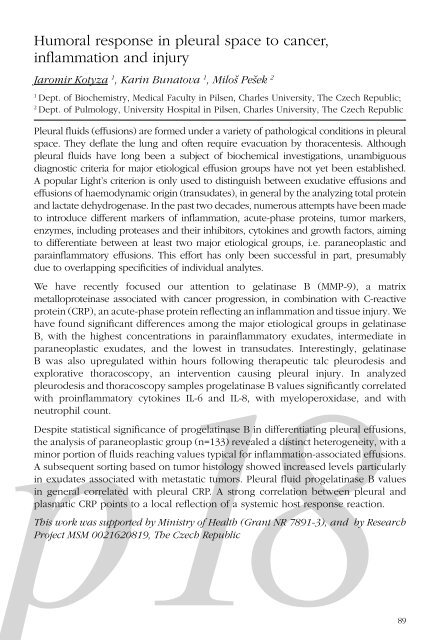Create successful ePaper yourself
Turn your PDF publications into a flip-book with our unique Google optimized e-Paper software.
Humoral response in pleural space to cancer,<br />
inflammation and injury<br />
Jaromir Kotyza 1 , Karin Bunatova 1 , Milo{ Pe{ek 2<br />
1<br />
Dept. of Biochemistry, Medical Faculty in Pilsen, Charles University, The Czech Republic;<br />
2<br />
Dept. of Pulmology, University Hospital in Pilsen, Charles University, The Czech Republic<br />
Pleural fluids (effusions) are formed under a variety of pathological conditions in pleural<br />
space. They deflate the lung and often require evacuation by thoracentesis. Although<br />
pleural fluids have long been a subject of biochemical investigations, unambiguous<br />
diagnostic criteria for major etiological effusion groups have not yet been established.<br />
A popular Light’s criterion is only used to distinguish between exudative effusions and<br />
effusions of haemodynamic origin (transudates), in general by the analyzing total protein<br />
and lactate dehydrogenase. In the past two decades, numerous attempts have been made<br />
to introduce different markers of inflammation, acute-phase proteins, tumor markers,<br />
enzymes, including proteases and their inhibitors, cytokines and growth factors, aiming<br />
to differentiate between at least two major etiological groups, i.e. paraneoplastic and<br />
parainflammatory effusions. This effort has only been successful in part, presumably<br />
due to overlapping specificities of individual analytes.<br />
We have recently focused our attention to gelatinase B (MMP-9), a matrix<br />
metalloproteinase associated with cancer progression, in combination with C-reactive<br />
protein (CRP), an acute-phase protein reflecting an inflammation and tissue injury. We<br />
have found significant differences among the major etiological groups in gelatinase<br />
B, with the highest concentrations in parainflammatory exudates, intermediate in<br />
paraneoplastic exudates, and the lowest in transudates. Interestingly, gelatinase<br />
B was also upregulated within hours following therapeutic talc pleurodesis and<br />
explorative thoracoscopy, an intervention causing pleural injury. In analyzed<br />
pleurodesis and thoracoscopy samples progelatinase B values significantly correlated<br />
with proinflammatory cytokines IL-6 and IL-8, with myeloperoxidase, and with<br />
neutrophil count.<br />
Despite statistical significance of progelatinase B in differentiating pleural effusions,<br />
the analysis of paraneoplastic group (n=133) revealed a distinct heterogeneity, with a<br />
minor portion of fluids reaching values typical for inflammation-associated effusions.<br />
A subsequent sorting based on tumor histology showed increased levels particularly<br />
in exudates associated with metastatic tumors. Pleural fluid progelatinase B values<br />
in general correlated with pleural CRP. A strong correlation between pleural and<br />
plasmatic CRP points to a local reflection of a systemic host response reaction.<br />
This work was supported by Ministry of Health (Grant NR 7891-3), and by Research<br />
Project MSM 0<strong>02</strong>1620819, The Czech Republic<br />
p1889
















